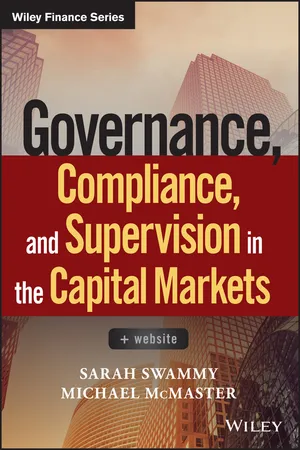Economics
Market for Capital
The market for capital refers to the buying and selling of financial assets such as stocks, bonds, and other securities. It is where individuals, businesses, and governments raise funds by issuing these assets and where investors purchase them. This market plays a crucial role in allocating capital to its most productive uses in the economy.
Written by Perlego with AI-assistance
Related key terms
7 Key excerpts on "Market for Capital"
- Sarah Swammy, Michael McMaster(Authors)
- 2018(Publication Date)
- Wiley(Publisher)
CHAPTER 1 Capital Markets Participants, Products, and FunctionsThis chapter provides an introduction to the participants, products, and functions of capital. We also discuss the important role capital markets play in supporting economic growth and development (Figure 1.1 ). We start with a detailed discussion of key participants and how capital markets support their economic activities. We then introduce the foundational product groups offered and review their key features and uses. Then we will explain the various types of markets and how they facilitate the funding and investing needs of participants.Capital markets environment.FIGURE 1.1THE BASIC PRODUCTS OFFERED IN CAPITAL MARKETS
For the focus of our discussion we view capital markets as offering two types of funding products to issuers: Equities and debt (also called fixed income) through both primary (initial issuance of securities) and secondary (ongoing trading of securities) markets. From a broader perspective, capital markets may also include the trading commodities, currencies, and derivatives.Equities
Equities, also known as shares and stocks, represent an ownership interest in a corporation; the term share means each security is a share of ownership in a corporation. Shares have the same limited‐liability rights of the corporations they represent, which means that the liability of share owners is limited to their investment amount. Shares are initially created when a corporation is formed, whereby the owners can choose the number of shares appropriate for the corporation's plans and valuation. At this point the corporation is known as a private corporation, as all the shares are held by a close group of investors.As corporations grow, some may choose to become a public corporation, or one that is listed on a public stock exchange, where members of the public can openly buy or sell shares. This process is known as listing where existing or additional shares may be created and offered to the public through an initial public offering (IPO).- eBook - ePub
- Khosrow Fatemi, Dominick Salvatore(Authors)
- 2012(Publication Date)
- Routledge(Publisher)
Capital markets can play a leading role in the economic recovery of highly indebted countries. Innovative financial intermediation promotes economic growth. Financial assets tailored to meet liquidity, returns, and risk-aversion requirements of investors induce greater savings. In turn, this induces growth by improving monetary policy, lowering costs of capital, and increasing the set of feasible investments in an economy. Capital markets activity is an important part of these processes. Securities markets strengthen the financial system and make an economy more stable and richer in alternatives for savings and corporate financing. Moreover, capital formation in the capital markets is directly linked with gross fixed capital formation in an economy. Similarly, efficient capital markets provide an important frame of reference for portfolio choices, efficient resource allocation in an economy, and sound corporate decisions. In addition, widely held corporate ownership socializes risk, returns, and corporate decision making. Efficient capital markets also promote the mobilization of international resources. Capital markets enhance government efficiency and development policies. They provide the government with key indicators for decision making and for monitoring the economy. Capital markets provide governments with alternatives for sound financing and the formulation of socially validated development projects. In turn, through regulation, proper macroeconomic and financial policy making, and a balanced participation in the capital markets, governments can play a key role in the development of capital markets, which are often inefficient in developing countries. Thus, in the aftermath of the debt crisis it is imperative to promote capital market development as a way to increase local savings and induce favorable international capital movements to promote private business activity, as well as a more efficient, balanced, and socially valid participation of the government in economic growth in developing countries. Considering the credit and foreign direct investment crunch precipitated by the debt crisis and current changes in Eastern Europe, the key for economic recovery of the developing countries lies in the ability of these countries to increase local savings and induce favorable international capital movement to increase needed investments. - eBook - ePub
The Political Economy Of China's Financial Reforms
Finance In Late Development
- Paul Bowles, Gordon White(Authors)
- 2019(Publication Date)
- Routledge(Publisher)
It is useful in a discussion of the development of capital markets to distinguish between their impacts at three different levels. First, we can assess the impact of capital market development on the conduct and effectiveness of macroeconomic policy. Second, there is the effect on the inter-sectoral allocation of financial resources. Third, there is the impact on the microbehaviour of enterprises. Regarding bonds, it is the first two levels which are the most relevant.Bonds are simply contracts between an issuer and a purchaser; in return for a specified sum of money advanced by the purchaser, the issuer agrees to make payments (usually of interest and principal) to the purchaser at specified dates. Beyond this, there is a considerable diversity in the terms of and types of bonds which are issued in advanced capitalist economies. They are issued by governments and firms to cover deficits and acquire assets; the different characteristics (in terms of risk, repayment conditions, etc.) of bonds are reflected in different prices determined by competitive markets. For governments, bond sales and purchases also form an important component of monetary policy through open market operations. For purchasers, bonds represent a vehicle for ensuring specified income flows in the future. However, purchasers do face the risk of default by the issuer, and when inflation is unpredictable, there is no guarantee of the purchasing power of the specified nominal income flow. Well-developed secondary markets usually exist which increase the liquidity of bond holding and also raise the possibility of the purchaser experiencing capital gains or losses as a result of interest rate changes. Thus, in capitalist economies, bonds enable governments to raise resources and provide them with a tool for monetary policy, whilst, in theory, the competitive issuing of bonds directs financial resources to their most profitable uses. - eBook - ePub
Intermediate Microeconomics
Neoclassical and Factually-oriented Models
- Lester O. Bumas(Author)
- 2015(Publication Date)
- Routledge(Publisher)
CHAPTER FOURTEENThe Market for Capital GoodsThe Market for Capital goods is crucial to the economy. Since Adam Smith we know that capital goods are the important source of productivity growth, growth in the standard of living, and the wealth of nations. But capital goods may also have a negative effect on the economy. John Maynard Keynes contended that spending on capital goods, investment spending, is volatile and the cause of the business cycle. The Market for Capital goods is, accordingly, of great interest and importance. A basic assumption is that the supply of capital goods responds demand. As a result, the concern of this chapter is with the demand for capital goods.The demand for capital goods can be called the demand for investment goods. This is because spending on capital goods often requires large monetary outlays with profits dependent on the flow of future revenues and costs. Because of the magnitude of the funds required, investment spending tends to be shown as a function of the interest rate. As a result the Market for Capital goods and the markets which set interest rates are examined here.Categories of Capital Goods
Recall the two forms of capital goods as delineated by our classical forebears: fixed and circulating. Structures and equipment are categorized as fixed capital-even though the purchase of much equipment is more quickly accomplished than the employment of additional labor. A capital good which is transformed into the final product goes by the name of circulating capital—but the word circulating is less than descriptively ideal. Thus, allow another look at the three forms of capital goods: structures, equipment, and inventories.Structures
Structures are categorized as non-residential and residential. The former generally serve as the locus of work of one sort or another. The latter structures comprise the indoor living space of the populace. Structures are basic to production and the conduct of family life. - Jiange Li, China Development Research Foundation(Authors)
- 2016(Publication Date)
- Routledge(Publisher)
Securities markets require information flows that are public and transparent. If that is achieved, price information moves at a lower cost and higher speed than in any other market. Innumerable unrelated investors rely on this information to determine how they want to invest, and this greatly reduces the costs of their transactions. Given that capital markets stimulate competition, they also mobilize people’s intelligence to achieve results. Capital markets enable the transfer of risk by allowing those who want to take risk to use financial instruments to achieve their aims. Capital markets have powerful property rights restraints, so that anyone who wants to participate must take into full consideration the potential returns on his investment of capital. Anyone who wants to make a profit must take into consideration the risk involved, and his responsibilities for paying back the funds. Professional brokers in the stock market provide a fairly uniform standard for evaluating performance of underlying companies. Managers of those companies are motivated to improve their performance, and this then creates social benefit as well as the ability to accumulate capital.For the above reasons, securities markets have been adopted by most countries in the world. China has achieved initial success with its own markets, which are showing very considerable vitality.Our problem today, however, is that people now have overly high and unrealistic expectations of the capital markets. They do not lack adequate understanding of the role that markets can play, but they need to understand that there are many things markets cannot do. Capital markets will fail if the demands on them are unrealistic. For example, capital markets cannot provide capital for free. The idea of fund-raising via capital markets was over-emphasized in recent years. One of the starting points for having a market was indeed that some companies lacked funding sources. Many companies then undertook shareholding reform for the sole purpose of allowing them to participate in the market and raise funds. This is indeed important for China right now, given its structure of aggregate savings. The markets serve as a way to transform net savings into a source of funding for both the government and enterprises. However, if people over-emphasize this fund-raising function of markets, the results can distort the mechanisms and very image of the stock market.- Maureen Burton, Reynold F. Nesiba, Bruce Brown(Authors)
- 2015(Publication Date)
- Routledge(Publisher)
Part 4 Financial Markets- The Money Markets
- The Corporate and Government Bond Markets
- The Stock Market
- The Mortgage Market
Passage contains an image
Chapter Eleven 11 The Money Markets
DOI: 10.4324/9781315706405-15The need for a money market arises because receipts of economic units do not coincide with their expenditures. —Timothy Q. Cook and Robert K. LaRocheLearning Objectives
After reading this chapter, you should know:- What the money market is and how it is used by various participants
- Recent trends in money market instruments
- How the money markets have become international in scope
- What money market mutual funds are and why they have become important intermediaries
Financial Markets
In Part 4 of this text, we examine debt and equity markets more closely. The next three chapters look at the various capital markets, where financial assets with a maturity of greater than one year (or no maturity at all) are traded. Capital markets include the bond, stock, and mortgage markets and we spend a chapter discussing each one. In this chapter, we look at the money market—the short-term credit market where debt securities having original maturities of one year or less are traded. This definition distinguishes the money market from the capital market for longer-term debt and equity transactions. We begin by exploring how various participants use money market instruments to meet their borrowing and lending needs. In the second section, we review the individual money market instruments (originally covered in Chapter 3 ) and the development of money market mutual funds (MMMFs).- eBook - ePub
Finance
Capital Markets, Financial Management, and Investment Management
- Frank J. Fabozzi, Pamela Peterson Drake(Authors)
- 2009(Publication Date)
- Wiley(Publisher)
money market funds and have restrictions as to what they can invest under U.S. securities law. Preferred stock would qualify if certain conditions are satisfied.Capital Market
The capital market is the sector of the financial market where long-term financial instruments issued by corporations and governments trade. Here “long-term” refers to a financial instrument with an original maturity greater than one year and perpetual securities (those with no maturity). There are two types of capital market securities: those that represent shares of ownership interest, also called equity, issued by corporations, and those that represent indebtedness, issued by corporations and by the U.S., state, and local governments.Earlier we described the distinction between equity and debt instruments. Equity includes common stock and preferred stock. Because common stock represents ownership of the corporation, and because the corporation has a perpetual life, common stock is a perpetual security; it has no maturity. In later chapters we describe common stock in more depth. Preferred stock also represents ownership interest in a corporation and can either have a redemption date or be perpetual.A capital market debt obligation is a financial instrument whereby the borrower promises to repay the maturity value one year after issuance. These debt obligations can be broken into two categories: bank loans and debt securities. While at one time, bank loans were not considered capital market instruments, in recent years a market for the buying and selling of these debt obligations has developed. One form of bank loan that is bought and sold in the market is a syndicated bank loan. This is a loan in which a group (or syndicate) of banks provides funds to the borrower. The need for a group of banks arises because the amount sought by a borrower may be too large for any one bank to be exposed to the credit risk of that borrower.Debt securities include (1) bonds, (2) notes, (3) medium-term notes, and (4) asset-backed securities. The distinction between a bond and a note has to do with the number of years until the obligation matures when the security is originally issued. Historically, a note is a debt security with a maturity at issuance of 10 years or less; a bond is a debt security with a maturity greater than10 years.8
Index pages curate the most relevant extracts from our library of academic textbooks. They’ve been created using an in-house natural language model (NLM), each adding context and meaning to key research topics.






